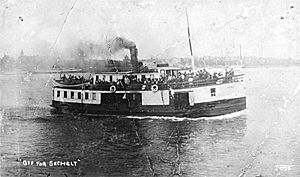Hattie Hansen

Sechelt ex Hattie Hansen ca 1910
|
|
| History | |
|---|---|
| Name: | Sechelt (ex Hattie Hansen) |
| Owner: | Hansen and Sons (1894 to 1903); J.F. Curtis & Sons (1903 to circa 1909); Sechelt Towage Co. (circa 1909 to 1911); British Columbia Steamship Co. (1911) |
| Route: | Lake Washington, Seattle-Dogfish Bay, Hood Canal, Seattle-Poulsbo, Everett-Coupeville, Vancouver, BC-Sechelt, Victoria-Sooke |
| Builder: | Lee Shipyard, Sand Point, Lake Washington |
| Launched: | 1893, in Lake Washington |
| In service: | 1893 |
| Fate: | Sank 24 March 1911 |
| General characteristics | |
| Type: | inland steamboat, passenger/freighter |
| Length: | 83 ft (25 m) |
| Beam: | 15 ft (5 m) |
| Installed power: | steam engine |
| Propulsion: | propeller |
| Notes: | Insured for $9,000 on date of loss |
The steamship Sechelt operated from 1893 to 1911 on Lake Washington, Puget Sound and the Strait of Georgia. For most of her career, she was called Hattie Hansen. She became well known following her unexplained sinking with no survivors near Race Rocks Lighthouse in 1911.
Hattie Hansen was built in 1893 on Lake Washington by the Edward F. Lee Shipyard at Sand Point. She was ordered by Capt. J.C. O'Connor for service on the lake. Before construction was complete, O'Connor sold her to Ole L. Hansen (1875–1940), one of the Hansen family which operated steamboats on Puget Sound.
Later in 1893 Hattie Hansen was brought out to the sound through the Duwamish River, which at that time connected to Lake Washington. Her new owners, the Hansen family, put her on the route from Seattle to Dogfish Bay, (or Liberty Bay as local residents prefer.) Capt. J.J. Hansen served as her master. In 1898 she was switched over to the Hood Canal mail route for a time, later returning to the Seattle - Poulsbo route, where she stayed until 1902. Her last master on the Poulsbo run was Capt. Alf Hostmark (1875–1953). J.F. Curtis and Sons bought Hattie Hansen in 1903 and put her on the Everett - Coupeville route, under Capt. A.H. Curtis, where she ran until the ferry Whidby was placed on the route, and she was sold to a Canadian firm.
The new Canadian owners renamed the vessel Sechelt, a town, peninsula and inlet in British Columbia, all ultimately named after the Shishalh people, one of the First Nations of British Columbia. Sechelt was first placed on the Vancouver – Sechelt route up the Strait of Georgia, under the command of Captain Robert Reginald Clarke. Capt Leopold Arther Bernays also commanded Sechelt from June to about the end of September or October. In 1910 Sechelt had some difficulties on this route; striking a reef at the Vancouver harbor entrance in August, and going ashore at Bowen Island in November.
...
Wikipedia
